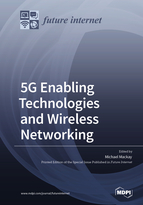5G Enabling Technologies and Wireless Networking
A special issue of Future Internet (ISSN 1999-5903). This special issue belongs to the section "Internet of Things".
Deadline for manuscript submissions: closed (23 May 2022) | Viewed by 21513
Special Issue Editor
Interests: wireless communications; radio resource management; internet protocols; IoT; computing continuum
Special Issues, Collections and Topics in MDPI journals
Special Issue Information
Dear Colleagues,
The ongoing deployment of 5G networks is seen as a key enabler for realizing upcoming services at scale, including the massive deployment of the Internet of Things, providing V2X communications to support autonomous vehicles, and the rise of smart homes, smart cities, and Industry 4.0. However, as the limitations of existing approaches become apparent, the need for next-generation technologies is growing, in terms of improving spectral efficiency, increasing network data rates and densification, supporting local/wide area wireless coordination, and more.
In this Special Issue, we are particularly interested in 5G and beyond enabling technologies to meet these access, efficiency, and performance requirements, and facilitate coordinating wireless networks to support future deployments. This primarily includes smart protocol design and access schemes, intelligent distributed collaboration platforms, and heterogeneous spectrum programming approaches but will undoubtedly extend to include a range of related areas such as Machine Learning enabled decision-making platforms, new physical layer security schemes, and device energy and quality of experience optimisation.
Dr. Michael Mackay
Guest Editor
Manuscript Submission Information
Manuscripts should be submitted online at www.mdpi.com by registering and logging in to this website. Once you are registered, click here to go to the submission form. Manuscripts can be submitted until the deadline. All submissions that pass pre-check are peer-reviewed. Accepted papers will be published continuously in the journal (as soon as accepted) and will be listed together on the special issue website. Research articles, review articles as well as short communications are invited. For planned papers, a title and short abstract (about 100 words) can be sent to the Editorial Office for announcement on this website.
Submitted manuscripts should not have been published previously, nor be under consideration for publication elsewhere (except conference proceedings papers). All manuscripts are thoroughly refereed through a single-blind peer-review process. A guide for authors and other relevant information for submission of manuscripts is available on the Instructions for Authors page. Future Internet is an international peer-reviewed open access monthly journal published by MDPI.
Please visit the Instructions for Authors page before submitting a manuscript. The Article Processing Charge (APC) for publication in this open access journal is 1600 CHF (Swiss Francs). Submitted papers should be well formatted and use good English. Authors may use MDPI's English editing service prior to publication or during author revisions.
Keywords
Beyond 5G technologies;
Massive IoT M2M and D2D use cases;
Spectrum programming and Radio Resource Management;
Spectrum sharing and coordination;
Wireless protocol design and random/grant free access models;
Radio channel modelling;
Performance analysis for energy efficiency latency and quality of experience.






